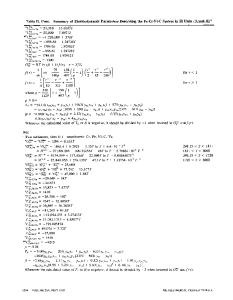A thermodynamic evaluation of the Fe-Cr-Mn-C system
- PDF / 766,294 Bytes
- 9 Pages / 597.28 x 785 pts Page_size
- 70 Downloads / 279 Views
I.
INTRODUCTION
THE Fe-Cr-Mn-C system is one o f the promising alloy systems due to low cost, favorable conditions for availability, and distinctively l o w e r density than that o f the existing superalloys (nickel or cobalt-base), tl] Knowledge o f the phase equilibrium relations in the Fe-Cr-Mn-C system would be essential f o r understanding the behavior o f the alloy steels in heat treatment and would be the foundation for improving the property o f steels o r designing new alloy steels. There is a large amount o f literature on the high Cr and Mn steels. However, most Of these reports concern the change o f mechanical properties during tempering at several temperatures. Experimental information on thermodynamics and phase equilibria is relatively sparse. Recently, thermodynamic m o d e l parameters o f various alloy systems have been evaluated from experimental phase equilibrium a n d / o r thermochemical data by the C A L P H A D (CALculation o f P H A s e Diagram) method, t21 An assessed set o f thermodynamic parameters for an alloy system can be used to calculate phase diagrams o f that alloy system and can be combined with data sets for o t h e r alloy systems to predict phase equilibria o f higher order systems. The purpose o f the present work is to obtain an optimized set o f thermodynamic parameters o f the F e Cr-Mn-C system based on the relevant experimental information and thermodynamic descriptions o f the l o w e r order systems. The thermodynamic descriptions o f the Fe-C system by Gustafson[3] and the Fe-Cr by Andersson and Sundman]4~ were accepted in the present work. For the Cr-C and Fe-Cr-C systems, a recent work by Lee,tSJ who reviewed the relative stabilities between each Cr carbide and between Cr and V or W carbides, and reassessed the Cr-C, Fe-Cr-C, and Ni-Cr-C systems, was accepted. Recently, two separate works on the assessments o f the Fe-Mn, Mn-C, and Fe-Mn-C systems have been reported by Huang [6'7,81 and Lee and Lee[9,1°1 independently. The work by Huang was accepted because the description o f pure manganese used by Lee and Lee was different from the SGTE (Scientific Group Thermodata Europe) database, to which the present work was BYEONG-JOO LEE, Senior Researcher, is with the Standard Reference Data Group, Korea Research Institute of Standards and Science, Taedok Science Town, Taejon 305-606, Republic of Korea. Manuscript submitted August 5 , 1992. METALLURGICAL TRANSACTIONS A
intended to contribute. Recent descriptions o f the Cr-Mn and Fe-Cr-Mn systems by Leet~ll were accepted, and an assessment o f the Cr-Mn-C system was included in the present work. II.
THERMODYNAMIC MODELS
The Fe-Cr-Mn-C system is composed o f the following phases: ~(bcc), T(fcc), f l - M n , a - M n , liquid, e(hcp), M23C6, M7C3, Cr3C2, cementite, Cr3Mns, Mn~sC4, MnsC2, graphite, and the sigma phase. The sublattice m o d e l t12"131 was applied to describe the Gibbs energy o f individual phases. A . Interstitial Solid Solution Phases [Bcc, Fcc, f l - M n , a - M n , e(hcp)] The Gibbs energy o f the body
Data Loading...











